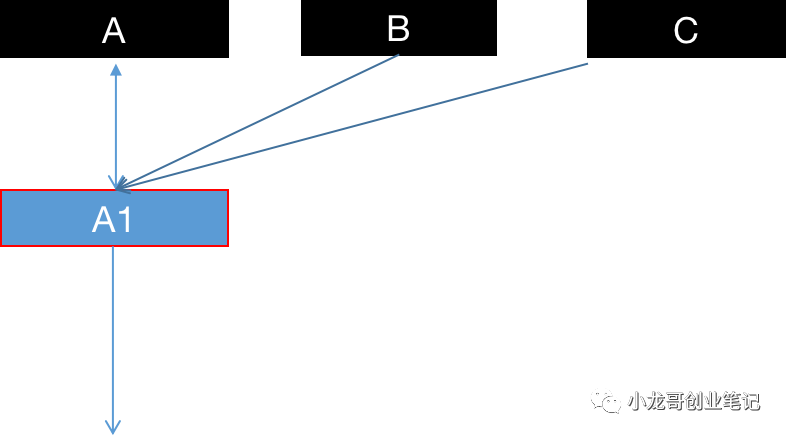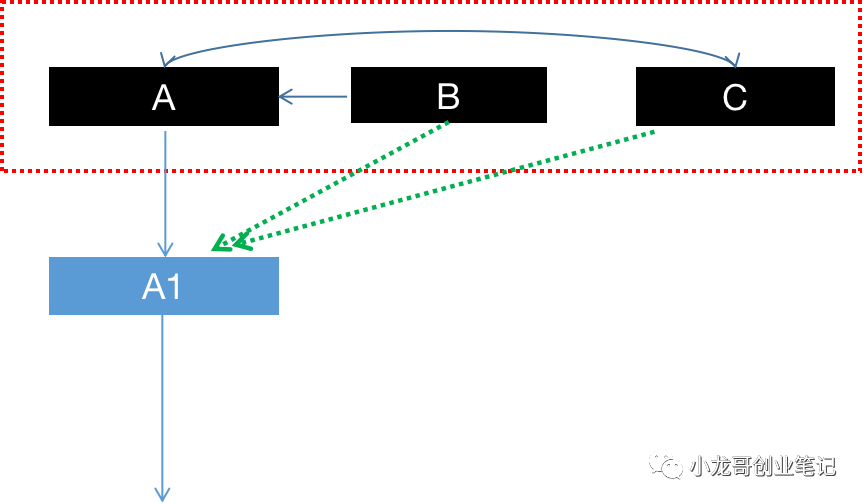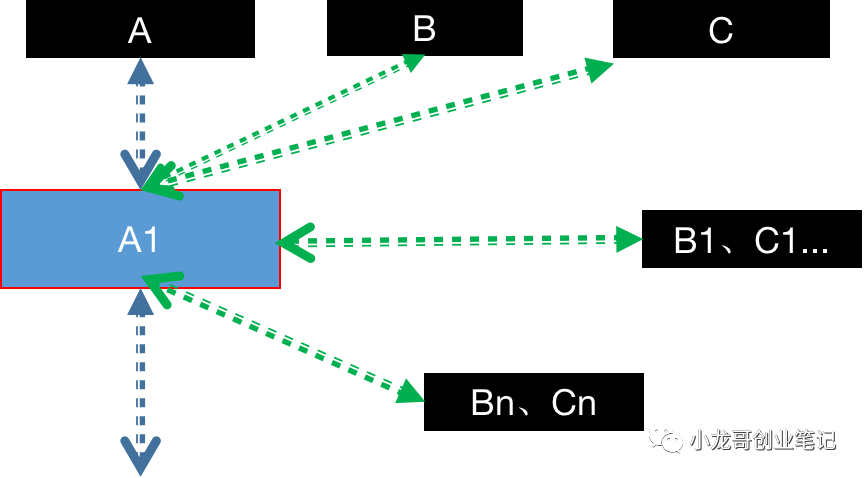Multi-management, also called multi-head management, refers to a management method in which an employee has multiple superiors. Maybe there will be big organizational problems, how to improve?
Editor’s note: This article is from the micro-channel public number “Xiaolong Ge entrepreneurial notes” (ID: mmxlgkym), Author: Chang Xing Long.
Multiple management, also called multi-head management, refers to a management method in which an employee has multiple superiors. In the matrix management model, there will be at least two levels of management. Everyone has to face a business leader and a professional leader. A typical multiple management structure is as follows:
(Figure 1) A typical multiple management
Among them, A1 is the Owner of the matter, and A, B, and C are all higher-ranked than A1, and they can have some evaluation rights for A1’s work, such as A for business line evaluation of A1’s work performance, B for professional serial evaluation of A1 Title, C is used as the soft quality score of HR evaluation A1. It is okay if the three opinions of A, B, and C are in agreement. If they are inconsistent, the work of A1 will be extremely difficult.
ZeroMultiple management is inevitable, but it can be greatly improved
If all decisions are made by one person, there will be organizational risk vulnerabilities, and if the forces of different departments are superimposed and integrated, multiple management problems will arise. The original goal of multiple management is to work together to make things better. The root of the danger is that when opinions are not unified, it will be more destructive. Everyone has their own experience, perspective, and their own ideas and principles for doing things. Their views and reactions to the same thing are different, and the solutions are naturally different.
Because the external environment that the company faces is uncertain, the most likely problems are not the same as any previous problems. In the face of new things, human history cannot quickly reach a consensus. (Think about the epidemic in the near future, and in the past think about Pythagoras’s argument that “the earth is round”). The uncertain environment and the uncertain stress response of different people will almost certainly lead to differences of opinion. Objectively speaking, multi-management caused by differences of opinion is inevitable. What the company has to solve is only in which level of unity and how to unite problem.
01The hazards of multiple management
Failure to solve multiple management problems means that the company’s power is scattered and personal growth is slow. Multiple tubeFrom the above expressions, if the project owner has a deep understanding of the business and is mature and has a method, he can give a plan to get a multi-way and arrogant leader, and naturally there will be no problems. But on the contrary, if you don’t handle it well, there will be factional issues and inaction issues, making power messy, increasing entropy, and bad money driving out good money. This will make the company fall into no one dares to take responsibility, no one is willing to take responsibility, and rely on everything. The boss shot the situation.
Many immature classmates will fall into a prisoner’s dilemma if they can’t break through, face problems and dare not take the lead, expose and solve the problems, when they can’t break through, there are only three ways to go: (1) Mixed So, there is no subjective initiative, and every time I have worked hard to synthesize multiple opinions, and finally I gave everyone’s opinions for reference, and no one was so satisfied with the plan and negotiated. (2) I can’t stand it anymore and leave. (3) It has grown up miraculously and convinced everyone to advance the project. If the organization does not give the environment, it will generally not appear at all. Even if the individual appears, it will be no problem at his level, and the same problem will begin to appear at the lower level.
So, how to solve this problem organizationally?
02Improvement 1: The organization can understand the situation across levels, but tasks must be assigned level by level
Two main results of multiple management issues:
1. The solution given is four different, and things are not optimal.
2. The frontline students cannot make decisions, have no contribution value, and cannot grow.
How to improve it?
HR said that this is obviously impossible. If you follow this line of thinking, no opinion can come in. Every level listens to the upper level. In the end, everything in this company must pass the CEO, and everything is the CEO. Make a decision, the ceiling of this kind of enterprise will be very low, which is not conducive to teamwork and common development, you say one more.
A1 reluctantly said that I can communicate with the big guys, but I hope that the big guys can unify their opinions before they give me their opinions. As long as they agree, I can do it. This is as shown in the figure below (Figure 2).
(Picture 2) A1 expects to return to the superior unity
Among them, the green dotted line is the line to understand information, and the blue solid line is the command line. The progress of this plan lies in:
1, B and C no longer direct A1 directly, and because B, C and A areAt the same level, consultations can be done on an equal footing, and there will be no sense of oppression, making the discussion of issues more thorough and forming a unified understanding.
2. As far as the company is concerned, we have achieved cross-level understanding of the situation and communicated tasks level by level. In terms of A1 alone, there are no multiple management problems.
Is the problem solved like this?
Obviously no, there are at least two disadvantages:
1, A1 still has not contributed its own value, and is still a complete executor, unable to grow.
The essence is that in the chaotic state, A1 gave up its own subjective initiative, did not contribute its own value creation, and directly passed this responsibility to the superior. The frightening thing is that A1 does not try to make any decisions and will never grow up. What’s more frightening is that it continues to deepen the impression that A1 is not good and cannot make decisions, forming a vicious circle. If things go on like this, there will be problems of team instability or slow growth, which is detrimental to the company and employees.
2. The problem has only been covered up and has not been fundamentally solved. The essence is just to move this multi-head management one level up. The equivalent deformation of Figure 2 is Figure 3, and this problem can be seen directly. Corresponding matrix management is that A1 chooses one of the business leaders or professional leaders to replace its decision-making functions.
(Picture 3) A1 returns the responsibility to the superior, and A completes the functions of A1
The essence of this approach is that A1 gave up growth and left the responsibility of the work that should have been undertaken by the superior A to complete it, resulting in more things through A. In the case of A’s limited energy, he should think about his own job. The time for the incident will inevitably be reduced. In addition, A has begun to face the problem of unified opinions and multi-head management. In the long run, the subordinates will not grow, and the superiors will not be able to make strategies. The leader is the firefighting captain, and everyone is the firefighter, fighting fires everywhere.
02Improvement 2: The superiors gradually delegate power, and the subordinates actively grow
How to improve this situation to make A1 gradually stronger, A can gradually delegate power, and everyone grows together? Let’s do some optimization.
First of all, before A1 does something, after communicating with A on the background and goals, he must accurately judge who is the associated person. The more accurate the judgment, the better, so as to avoid unnecessary interruption to unrelated students, and then callWhen the interest is fully given. As long as A1 can guarantee “listen to the opinions of the majority and fully discuss with a few (such as A and other key roles)”, it should have the right to decide on this matter. Once the photo is taken and willing to take the corresponding responsibility, A, B, and C are synchronized Decentralization.
3. Even if there is a mistake, the company needs to pay tuition to those who are responsible and willing to learn, so that they will gradually become the backbone of the company.
(Picture 5) A1 actively listens to the opinions of the majority, discusses with the minority, makes his own decisions and assumes responsibility
04Combining the above best practices
After understanding the deduction of multi-management, proceed to the problem of multi-management. This article gives a conclusion:
1. Multiple management is inherently inevitable. It is only a question of which level to solve and how to solve. Many management modes themselves are a form of multiple management, such as matrix management mode.
2. To solve this problem, from the perspective of best practice, the principles that need to be followed are:
(1) Management:
-
Determine the composition of the project members and the owner of the responsibility.
-
Select the owner, associated participant, and observer of each event as project members.
-
Ensure that the Owner is competent for this task. If it is still not competent, the superior leader needs to participate.
-
If the superior is also incompetent, you need to abandon the Owner and find that you are competent or can be competent in combination with the leader. The cp formed by the owner and its superior is called the owner combination.
-
Clarify that the project is the responsibility of the Owner or a combination of Owners.
-
Associated participants or observers can provide comments at the beginning of the project or during the progress, but need to ensure that the information reaches all members of the project. When efficiency is low or opinions are scattered and uncontrollable, the Owner/Owner combination quickly pulls the meeting into line. The recommended practice is to have at least one Startup meeting/email before the start of an important project, gather opinions, and describe clearly the goals, plans, partners and related interfaces.
-
Once the project starts, except for the Owner portfolio, all other Leaders follow the principle of not having one-line communication, understanding problems across levels, and issuing instructions level by level. Promote the Owner’s Coach work, try to delegate power as much as possible, and refine the Owner’s decision-making ability.
-
Fully communicate before the decision. Unless there are major mistakes after the decision, try to complete it as much as possible. The Owner organizes the review and summary, and saves the report in the project team’s mail group.
-
Owner must have a mechanism to move up and down.
(2) Owner:
-
Have the Owner spirit to take responsibility for decision-making, and the determination and courage to follow through Own’s matters. Before learning to do things, use Startup meetings/emails to collect possible differences.
-
Collect opinions from the majority, discuss with a few people, make your own decisions, logically persuade others to support the ideas you think is right, dare to make decisions and assume corresponding responsibilities.
-
Don’t be afraid of superiors, let alone superiors, learn to be responsible for things. Practice in-depth business thinking, logical expression skills, and project promotion skills.
-
Any unfavorable evaluations and opinions are the nourishment of progress, progress in criticism and self-criticism, and rapid breakthrough and growth in replay and self-denial.



